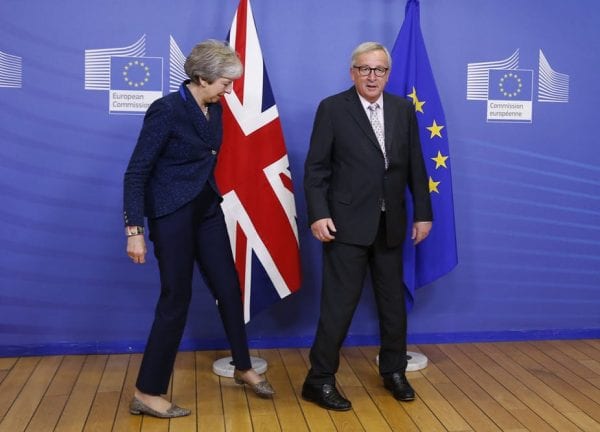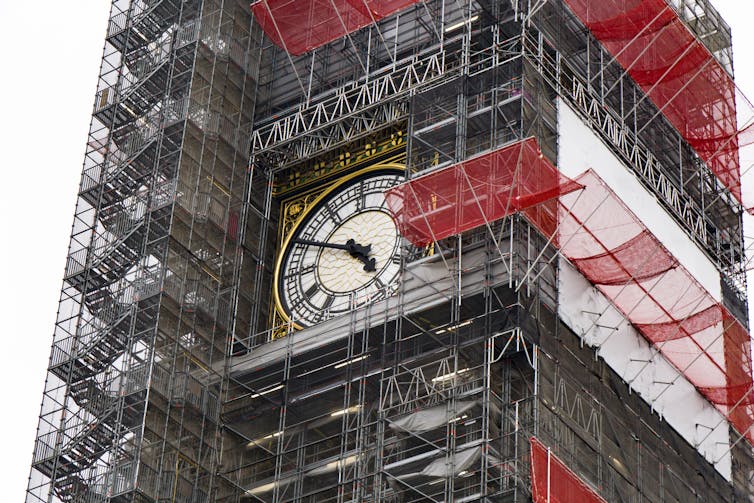
Julien Warnand/EPA
Nieves Perez-Solorzano, University of Bristol
As the December European Council drew to an end, EU leaders must have felt that they were living their own Brexit Groundhog Day. As has become the norm since the Brexit negotiations began in March 2017, the European Union is faced with a British government in crisis.
A string of cabinet resignations, dependence on Northern Ireland’s Democratic Unionist Party (DUP), and a mismatch between her negotiating red lines and the promise of a successful Brexit, have weakened Theresa May throughout the Brexit negotiation process. Today, the prime minister is an even weaker leader, at the helm of a disintegrating Conservative Party.
The prime minister attended the European Council meeting hoping that other 27 EU member states (EU27) would help her achieve the unachievable: a legal change to the withdrawal agreement that addresses domestic concerns about the Irish backstop sufficient to persuade a majority of MPs in Westminster to support her Brexit deal at some point before January 21, 2019.
Such steadfast support has not materialised. As the Brexit clock ticks, and the end game approaches, the European Council confirmed that the withdrawal agreement “is not open for renegotiation”. The Council conclusions of December 13 restated that the Irish backstop is intended as an “insurance policy to prevent a hard border on the island of Ireland”, but that if it were to nevertheless be triggered, “it would apply temporarily”.
The EU27 reiterated their intention that the backstop should “only be in place for as long as strictly necessary” and offered to start negotiations on the future relationship, “as soon as possible after the UK’s withdrawal.”
The EU27’s clear and succinct language hides the exasperation, disbelief, impatience, and polite understanding of May’s difficult predicament that have characterised European leaders’ reactions after what was a torrid week in which the prime minister delayed a vote in parliament on the Brexit deal and survived a leadership challenge.
This doesn’t exactly look like an exchange of pleasantries between Theresa May and Jean-Claude Juncker as the Brexit summit gets underway. #EUCO pic.twitter.com/l0r4NwDj8h
— Philip Sime (@PhilipSime) 14 December 2018
Despite a testy conversation caught on camera between May and the European Commission president, Jean-Claude Juncker, over the clarity of the British government’s position, the prime minister later insisted that “further clarification and discussion” were possible to ensure that the UK leaves the EU with a deal.
Parliament’s red lines
But something new is filtering through the EU’s narrative: a realisation that, until now, the negotiating partner has been the British government acting on May’s own red lines. But from now on it’s not May’s red lines that matter but those of the parliament in Westminster so that the withdrawal agreement can be ratified and an orderly Brexit ensured. Yet, to date, the British parliament lacks a common negotiating position of its own other than avoiding a no-deal Brexit.
As the prime minister of Luxembourg, Xavier Bettel, put it:
We know what Theresa wants, and she wants the best possible deal in Westminster, but the problem is the MPs in London.
Drawing on Denmark’s experience in negotiating the Maastricht Treaty in the early 1990s, Denmark’s prime minister, Lars Løkke Rasmussen’s advised: “It is now up to the British to come to … a national consensus as we did in Denmark when the Danish rejected the Maastricht treaty in order to tell us exactly what to do to get it through the British parliament.”
The challenge for the EU is that, despite the skillful negotiating strategy demonstrated throughout the Brexit process, there is very little it can do when its negotiating partner’s position is seen as “nebulous” and does not command the support of parliament or that of the wider public. Only 19% of the UK population support May’s Brexit deal, according to a recent YouGov study, while the majority of the population in Northern Ireland support the Irish backstop.

Daniel Tam/flickr.com, CC BY-NC-ND
Preparations for no deal?
The article 50 process allows an extension of the negotiating period. The UK would have to request such an extension. The EU would favour it in the event of a general election or another referendum and to avoid a “no-deal” Brexit. Nevertheless, preparations are being stepped up across the EU for such a scenario.
The EU27 has regularly said that no Brexit would be their preferred outcome. A recent ruling by the Court of Justice of the EU has confirmed that the UK can unilaterally cancel its notification to leave the EU. No Brexit has been recognised both by May and the president of the European Council, Donald Tusk, as one of the possible options should the British parliament not ratify the withdrawal agreement.
However, as Jean-Claude Piris, the former director general of the EU Council’s Legal Service, has confirmed the EU will not “approve any Protocol, codicil or even Declaration saying something which would not be legally in conformity with the terms of the Withdrawal Agreement” to appease the British parliament.
As the countdown to leaving the European Union reaches 100 days, the EU’s unanimous reaction to the crisis in the UK is clear: the withdrawal agreement is the only Brexit deal available and it is the UK’s government responsibility to find the domestic consensus to ratify the withdrawal agreement. No deal is not the preferred scenario, but the EU is ready for it.
Ivan Rogers, the UK’s former permanent representative to the EU, offered an excellent description of the challenges ahead in a recent speech at the University of Liverpool: “Brexit is a process not an event. And the EU, while strategically myopic, is formidably good at process against negotiating opponents. We have to be equally so, or we will get hammered.”![]()
Nieves Perez-Solorzano, Senior Lecturer in European Politics, University of Bristol
This article from 14th December 2018 is republished from The Conversation under a Creative Commons license. Read the original article.
